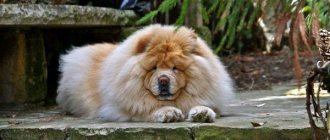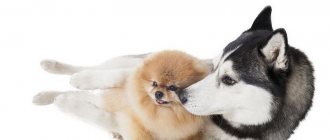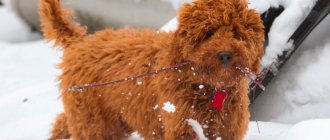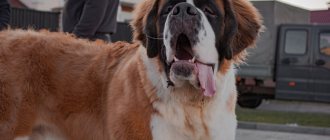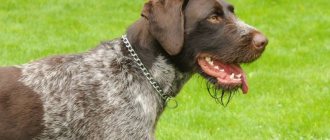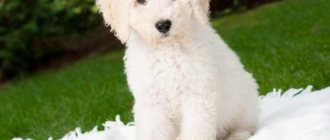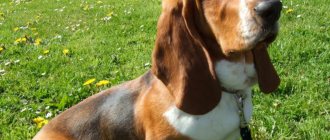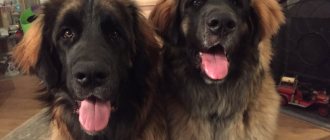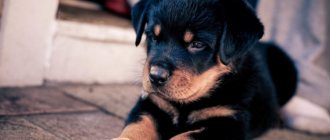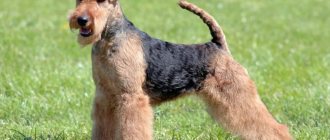The Chesapeake Bay Retriever is an American breed of gun dog that was bred to retrieve birds from the water and has all the qualities necessary for this job: an innate hunting instinct, friendliness, endurance and intelligence. They are also known for their waterproof coat and ability to work in the most adverse weather conditions.
Description and features
The Chesapeake Bay Retriever breed is quite large. The height of males reaches 58-66 cm with a weight of 31-36.5 kg, females - 54-62 cm with a weight of 26-32 kg. But appearance is created not by size, but by complexion. The Chesapeake, or Chessie for short, has a look of strength and endurance.
Perhaps this impression is made by a muscular neck, a voluminous chest and stable, even legs. In general, the dog looks powerful, but very harmonious. The main feature of these dogs is their purpose. They were bred to work on waterfowl in all weather conditions. And they are very good at this.
Tireless workers are able to swim for a long time in icy water, breaking the ice crust, and moving against the current and wind. And with age, these qualities do not disappear; the dog remains a worker, strong and efficient until the end of his life. Moreover, he can be called a professional with a capital P.
The Chesapeake Bay has excellent instincts and will find game in impassable areas.
Because, in the absence of hunting, he is fully trainable for guard and security service, the work of a guide, rescuer or nurse. Although American breeders, trying to maintain the status of a gun dog, do not encourage its use simply as a pet.
The Chesapeake Bay Retriever in the photo looks like a sculpted plush sculpture, especially when he assumes a stationary stance. Only his attentive and soulful eyes reveal him as a lively, devoted and very intelligent dog.
Chesapeake Energy Corporation Company Profile
Industry Oil & Gas Operations
SectorEnergy
Employees
2300
Equity Type
ORD
Chesapeake Energy Corporation is an exploration and production company. The Company is engaged in the acquisition, exploration and development of properties to produce oil, natural gas and natural gas liquids (NGL) from underground reservoirs. It operates in one segment: Exploration and Production, engaged in finding and producing oil, natural gas and NGL. It has a diverse resource base of onshore the United States unconventional natural gas and liquids assets. The Company has interests in approximately 13,500 oil and natural gas wells. It has positions in resource plays of the Eagle Ford Shale in South Texas, the stacked pay in the Powder River Basin in Wyoming and the Anadarko Basin in northwestern Oklahoma. Its natural gas resource plays are the northern Appalachian Basin in Pennsylvania and the Haynesville/Bossier Shales in northwestern Louisiana.
Read More
Breed standards and character
General appearance: muscular dog, with a rectangular body format, a wide skull and a moderately pronounced stop. The jaws are strong and large enough to carry prey without damaging it. The coat is short and coarse, with a dense undercoat. Can be a little wavy, but not on the paws.
It is impregnated with a specific composition of fat that protects the dog from hypothermia in icy water. The quality of the wool is very important when choosing, as it affects the efficiency of work. When leaving the water, the dog shakes himself off, and after this the fur should remain dry, like a goose feather.
Chesapeake Bay Retriever is a powerful, muscular dog.
Color is allowed in any brown tones - from the color of reeds to the shade of dried leaves. Plain color is most preferable. Although it is acceptable to have several white spots no larger than the size of the paw pads - on the chest, belly and bottom of the paws. Interestingly, when assessing appearance, noble scars do not affect the score.
The back is short and straight, the tail is also straight, only a slight curve is allowed, but not towards the body. All limbs are moderately high, straight, with strong muscles; in puppies the fifth and dewclaws are removed. The muzzle has the shape of a cone, pointed towards the nose. Scissor or straight bite.
The ears are thin, long, set tightly, hanging freely on the sides of the head. The movements are smooth, free, light, and you can feel the strength in them. When viewed from the front, the elbows and hocks should not stick out in different directions.
Eyes are a special element in the description of this dog. Their cut, as well as their amber color, make the dog look very intelligent, with an attentive look, and an interested and friendly expression.
According to the standard, the animal’s temperament must be “bright and happy.” Probably, the manufacturers put into this concept a cheerful, even character, courage, intelligence, flair, and willingness to work. They are characterized by tolerance towards all family members, especially children, and selfless devotion to the owner.
This dog breed needs long walks and swimming every day.
He always strives to curry favor with the person most important to him. They will not ignore a stranger’s aggression, although they themselves will not attack first. Animals with hydrophobia, malocclusion, excessively curly hair, black color and white spots, sizes and in places not provided for by the standard are disqualified.
Nova Scotian (toller)
The newest breed among Retrievers appeared in 1945 in Canada. Hunters needed a dog that could lure ducks to traps on the shore. From English “tolling” means luring a bird, which is where the name comes from. The standard was adopted in 1983.
This is the smallest dog among Retrievers. The height of the Nova Scotia Toller rarely exceeds 50 cm, and the maximum weight is 20 kg. Despite their size, animals do not like apartment life. They like a country house where they can walk in the yard.
The dogs look like foxes: a long rectangular body, a fluffy tail, a narrowed muzzle and a bright red color. White spots on the chest and head are characteristic. The coat is smooth, red, silky, consists of two layers: thick guard hair and soft, padded undercoat. The cover is waterproof.
Cheerful, active dog, devoted to family, non-aggressive. At home, Toller is calm, even melancholic. And in nature he is a real fidget. The retriever loves to play, hunt and run. He gets along with children, but does not like other pets. The dog is wary of strangers, so it can serve as a guard.
The dog cannot stand loneliness and cannot live in an enclosure. It is vital for an animal to be close to its owner and feel his love. The breed needs education, training and physical activity. Average cost of puppies: 60,000 rubles.
History of the breed
The Chesapeake Bay is essentially part of the Atlantic Ocean. Its unique appearance was the result of the formation of a crater, which was a kind of dam for the Susquehanna River. Due to the many rivers and rivulets (more than 150 large and about 100 thousand small) flowing into this estuary, the water there is cold, if not icy.
In such conditions, it was not easy for hunters to get shot game from the reservoir. At the beginning of the 19th century, an English sailing ship crashed off the coast of the continent, but the crew escaped and left two dogs from Newfoundland with the local population. They helped the natives pull wounded ducks out of the frozen water.
The Chesapeake Bay Retriever is an indispensable assistant for duck hunting.
The unique feature of being in the cold for a long time was noticed by hunting enthusiast and dog breeder Dr. James Stewart. He crossed a chestnut male from a pair of castaways with dark fawn Coonhound females.
Then, various breeders began to add Irish water spaniels, retrievers, and setters to the breed. It was finally formed in the second half of the 19th century, and instantly gained popularity among hunters for its courage, courage and endurance in difficult conditions.
The dog was registered in 1878 by the American Kennel Club. And the Chesapeake Club was legalized in 1918, and became the first retriever club in the United States. Today, up to 1,000 puppies are registered in their homeland per year. In terms of popularity there, the breed is second only to Labradors and golden retrievers.
Interesting Facts
The Chesapeake Bay Retriever is one of those breeds about which a lot of interesting things can be told:
- Since 1964, the Chesapeake Bay Retriever has been considered the national breed of Maryland. He is also recognized as the mascot of the University of Maryland, located in Baltimore County.
- The breed was named after the Chesapeake Bay, on the coast of which its history began.
- Chesapeake Bay Retrievers were among the dogs that helped search for people in the rubble of the September 11, 2001, tragedy in New York.
Care and maintenance
The Chesapeake Bay Retriever dog is very active and needs long walks every day. Otherwise, your personal belongings and pieces of furniture will suffer, and the dog, out of boredom, can make a real mess in the room. The best option is morning and evening departures for an hour.
Moreover, these should not be leisurely exercises; jogging, games, and trips to reservoirs are welcome. The dog loves to bathe and swim. Training a puppy is difficult, but it is better to do it yourself under the supervision of a professional. Otherwise, it will be difficult for the animal to decide who the real owner is.
The dog must have trust and respect for you, otherwise he will not listen. With patience and creativity, parenting can be fun for both of you. However, it must be taken into account that the character of the animal contains a share of stubbornness, therefore, at the slightest disobedience, it is necessary to make it clear that he is wrong.
There are no special problems in terms of coat care; it is enough to brush it daily with a stiff brush. But if you have such a pet at home, you should know in advance that they can emit an odor. And it is impossible to fight this, such are the properties of their unique waterproof fur. However, bathing with shampoo is often not recommended; three times a year is enough.
In addition, this is a labor-intensive procedure, since the wool gets wet very poorly. It is enough for a loving owner to devote a few minutes a day to examine the pet. Carefully examine the body for scratches, bald spots, and parasites. Next, check your eyes for redness or mucus. Feel free to not only look, but also smell the ears.
They should not have an unpleasant odor. Teeth are an important part of the examination. They must be snow-white. In addition to being clean, they can crack and split. It is necessary to clean the stone. The claws need to be trimmed once every 2-3 weeks, although most often the dog grinds them off on his own.
These powerful and intelligent dogs make excellent guards.
References
- Kohl, Sam; Catherine Coldstein (1984). The All Breed Dog Grooming Guide
. New York: Arco Publishing, Inc. p. 88. ISBN 0-668-05573-1. - Geeson, Eileen; Vetter, Barbara; Whitmore, Lia (2004). Ultimate Dog Grooming
. New York: Firefly Books. p. 158. ISBN 1-55297-873-7. - Horn, Janet; Dr. Daniel Horn (1994). The New Complete Chesapeake Bay Retriever
. New York: Howell Book House. pp. 179–181. ISBN 0-87605-099-2. - Lamb Free, James (1949). Training Your Retriever
. New York: Coward, McCann & Geoghegan, Inc. p. 38. - Horn, Janet; Dr. Daniel Horn (1994). The New Complete Chesapeake Bay Retriever
. New York: Howell Book House. pp. 55–63. ISBN 0-87605-099-2. - LaFond E, Breur GJ, Austin CC (2002). "Breed susceptibility for developmental orthopedic diseases in dogs." Am Anim Hosp Assoc
. - LJohnson G.S.; Turrentine MA; Kraus, K. H. (1988). "Canine von Willebrand's disease". Veterinary Clinics of North America
.
18
: 195–223. - Gelatt KN, Whitley RD, Lavach JD, Barrie KP, Williams LW (1979). "Cataracts in Chesapeake Bay Retrievers." Journal of the American Veterinary Medical Association
.
175
(11):1176–8.
Nutrition
Chesapeakes are not capricious in their choice of food, but the amount of protein and calcium in foods is of great importance for their diet. Already in childhood, it is worth deciding on the type of food to choose - natural, factory-made or mixed.
In the first case, the portion is calculated based on physical activity; overeating is extremely undesirable. From an early age, select the correct amount; if the puppy does not finish eating, reduce the dose. The Chessie has an excellent appetite, so he can quickly gain weight, and this leads to illness.
The second option is the most optimal, since it does not require additional vitamin supplements; high-quality factory feed is already balanced. The third option, like the first, should be supplemented with vitamins and minerals.
An important rule for natural feeding is no handouts from the table, scraps, sweet, spicy, or fatty pieces. Nutrition should be complete and healthy. Broth-based porridge, lean meat, vegetables and fruits, dairy products, herbs and always clean water.
What is the difference between a Golden Retriever and a Labrador?
Both breeds are hunting, gun breeds, designed for searching and carrying killed or wounded game. That’s why both Labradors and Goldens are excellent swimmers, love to fetch fetch objects, and can bring a chicken egg in their teeth without crushing it. Labrador Retriever or Golden Retriever? Many dog lovers mistakenly consider the Golden Retriever to be a long-haired version of the Labrador. This is wrong. Labrador is an independent breed, with its own standard of appearance and character traits, but since Labrador blood was actively used in the creation of the Golden, the two have some similarities:
- Both breeds are very friendly to people and dogs, do not show aggression, and avoid conflicts.
- Both breeds have an excellent sense of smell, which, coupled with their lack of aggression, makes them excellent rescuers and search engines.
But Labrador and Golden have many more differences than similarities:
- Labradors are a very old breed of dog, the Golden is the result of crossing several breeds.
- Coat length and color are the main visible differences. The Golden has long, light-colored hair, while the Labrador is short-haired and can be either fawn, chocolate or black.
- The Labrador's tail is "otter-like" and is raised cheerfully above the level of the back. The Golden Retriever's tail is more similar to that of a setter, resembling a "feather".
- The behavior of dogs of these two breeds also differs. Goldens are calmer, aristocratic, and are excellent nannies even for small children. Labradors have a certain simplicity and tactlessness, and in a fit of emotion they can drop a child or knock a shopping bag out of the owner’s hands.
- Labradors are more spontaneous in behavior, they are immensely active, and crave action. The Golden Retriever is more inclined to think about an action; he will carry out the owner’s order, but in his own way, more rationally.
DESCRIPTION OF THE BREED
The Golden Retriever is a large, harmonious, powerful dog. Fully formed by the second year of life, males reach 56-61 cm at the withers and weigh 29-42 kg, females 51-56 cm and weigh 25-37 kg.
The head is wide, the skull is slightly domed, proportional to the body, without sharp features. The stop is clearly pronounced, but not sharp. When viewed in profile, the narrow muzzle gradually becomes wider and smoothly passes from the muzzle to the forehead. At the same time, the parietal zone is pronounced and wide.
A nose that is black or brownish-black, a nose that is pink or has a significant lack of pigment is highly undesirable. Scissor bite. The eyes are large, widely spaced and with a friendly expression. Dark eye color is preferred, their expression is always confident, friendly and intelligent. The ears are medium in size, their lower edge begins approximately at eye level, and they hang down along the cheeks.
The main feature of the breed is its coat, shiny and luxurious, shimmering in different shades of gold. Thick and water-repellent, the double coat protects the dog from environmental influences during the hunt.
The straight or slightly wavy coat of the outer shirt lies close to the body, hard and elastic to the touch. The wool of the undershirt does not allow water to pass through and prevents the dog from getting wet during the hunt.
There is a mane around the neck, a small plume on the back of the front legs and on the underside of the body, and a clearly visible plume on the front of the neck, the back of the thigh and the underside of the tail. The hair on the head, paw pads and front legs is quite short.
The color of the coat should resemble gold or shades of gold. The only exceptions are for plumes, which may be lighter than the main color, and older dogs, whose coat may lighten or darken with age. Dogs of any other color, with visible dark or light spots, are discarded.
Despite the fact that this is a purebred breed, it is widespread throughout the world and different regions have developed their own types. There are: American Golden Retriever, English and Canadian.
Reproduction and lifespan
On the territory of the Russian Federation and the former countries of the Soviet Union, the Autumn breed is rare. There are no professional breeders here. Puppies should only be brought from abroad. There is no point in breeding it yourself - the trouble will not be worth it.
You should buy a baby only from nurseries with licensed activities, a good reputation and many years of breeding experience. You may find private breeders on the Internet whose prices will be lower, but in this case there is a high risk of getting a dog with hidden defects or not a pure breed.
Chesapeake Bay Retriever puppies should be able to fetch a toy or ball from childhood. When choosing a dog, pay attention to the appearance of the parents - your pet will look like them. If in doubt, look for another option. When purchasing, ask for all documents, including a veterinary passport with vaccination marks.
Observe the baby’s behavior; he should be playful, active, and not fearful. Check your hearing and vision - drop your keys nearby and wave your hand in front of him. Before you take home the little one you like, consult with a professional. Chesapeakes live for about 10 years. The most typical diseases are joint dysplasia, retinal atrophy, and skin diseases.
Training
If you previously had no idea about this dog breed, it is worth noting that it is quite independent. It is for this reason that during education and training you may encounter difficulties of a certain nature. In this case, the educational process should be carried out exclusively by the owner and no one else. If you don’t know how to raise such a dog, you can always get professional advice from a specialist. Preparatory courses must be taken, especially if you will use your pet for hunting. They do an excellent job with waterfowl. In this case, the dog’s loyalty to its owner must be instilled from puppyhood. For cooperation to be as fruitful as possible, the owner and dog must develop a trusting relationship. Do not forget that such a pet needs regular affection and attention. To ensure that your dog obeys and does everything you tell him, it is strongly recommended that you conduct classes in a playful manner. As a result of such training, everyone will be happy. The breed in question has an excellent memory, so they can easily learn even complex commands. The main thing is to praise your pet on time and pamper it with treats. If you notice that a dog begins to regularly show stubbornness during upbringing and training, you should know that these are the mistakes of the owner alone
Therefore, before getting such a pet, it is very important to know the characteristic features of the breed. It is for this same reason that you must have experience in raising dogs. If you can't handle it as a puppy, nothing good will come of it.
If you can't handle it as a puppy, nothing good will come of it.
Anatolian Shepherd - description of the breed and character of the dog
Treatment
Young dogs rarely get sick. There is almost no need to spend money on treatment if the animal is vaccinated. To understand approximately the costs of veterinary services, you need to find out their price:
- Preventive examination - 300 rubles;
- Sterilization - 1500 rubles (one-time).
The monthly budget for treatment cannot be calculated universally. But it is better to allocate at least $100 in advance for unplanned situations when emergency veterinary care is needed. But personal transport will solve the problem faster.
Often the package consists of the following types of services:
- Prevention;
- Elimination of parasites;
- Removal of fleas and ticks;
- Routine vaccinations;
- Revaccinations;
- Free appointments, examinations, consultations;
- Discounts for calling a veterinary care team.
Chronic diseases in a pet are a reason to see a veterinarian. Healthy dogs with strong immunity do not need a subscription; they can undergo a preventive examination and vaccination once a year. A service subscription can be recommended for nursery breeders who have at least 5 animals in their care.
Purpose of dogs
Today's purpose of flat dogs is as a companion dog. They can often be found at dog show competitions and agility venues. Dogs can serve as guides for the visually impaired and be excellent nannies for small children.
But, nevertheless, the flat-coated remains a hunting dog at heart, remembering its purpose at the first opportunity.
Today, the Flat-Coated Retriever breed is used as police and customs working dogs only in European countries. In England, the Flat is still considered the best gun dog and is used in hunting waterfowl.
In our country, straight-coated retrievers are often kept as domestic companion dogs, and are extremely rarely used in canistherapy.
